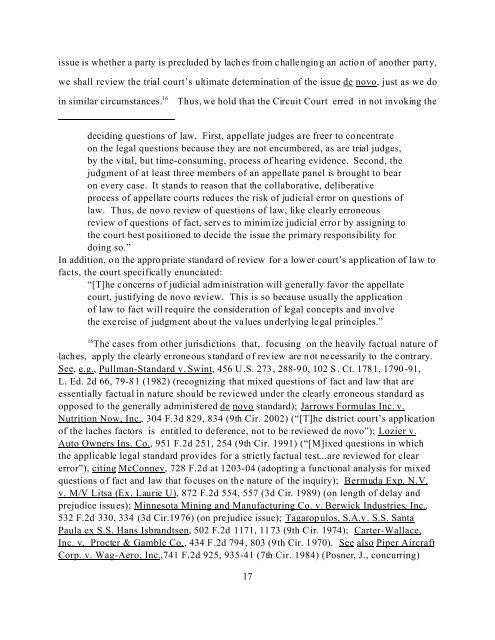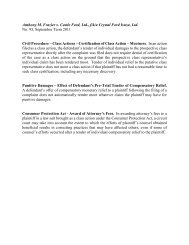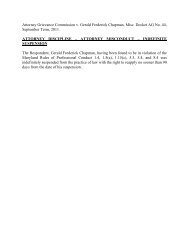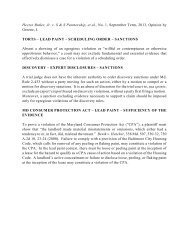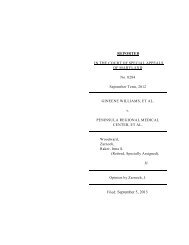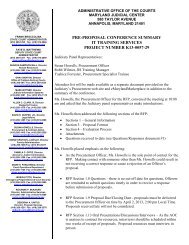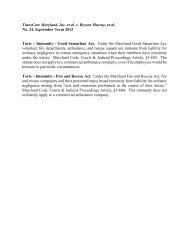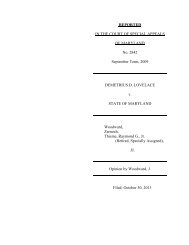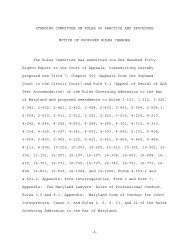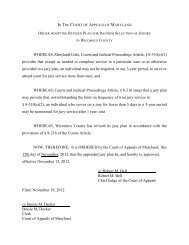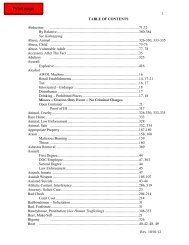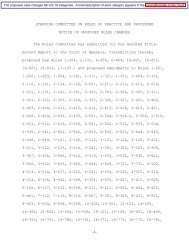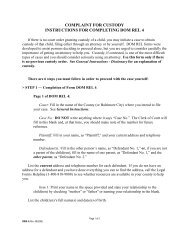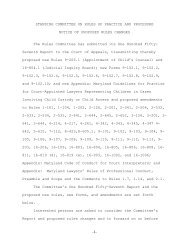Liddy v. Lamone - Maryland state court system
Liddy v. Lamone - Maryland state court system
Liddy v. Lamone - Maryland state court system
You also want an ePaper? Increase the reach of your titles
YUMPU automatically turns print PDFs into web optimized ePapers that Google loves.
issue is whether a party is precluded by laches from challenging an action of another party,<br />
we shall review the trial <strong>court</strong>’s ultimate determination of the issue de novo, just as we do<br />
in similar circumstances. 16 Thus, we hold that the Circuit Court erred in not invoking the<br />
deciding questions of law. First, appellate judges are freer to concentrate<br />
on the legal questions because they are not encumbered, as are trial judges,<br />
by the vital, but time-consuming, process of hearing evidence. Second, the<br />
judgment of at least three members of an appellate panel is brought to bear<br />
on every case. It stands to reason that the collaborative, deliberative<br />
process of appellate <strong>court</strong>s reduces the risk of judicial error on questions of<br />
law. Thus, de novo review of questions of law, like clearly erroneous<br />
review of questions of fact, serves to minimize judicial error by assigning to<br />
the <strong>court</strong> best positioned to decide the issue the primary responsibility for<br />
doing so.”<br />
In addition, on the appropriate standard of review for a lower <strong>court</strong>’s application of law to<br />
facts, the <strong>court</strong> specifically enunciated:<br />
“[T]he concerns of judicial administration will generally favor the appellate<br />
<strong>court</strong>, justifying de novo review. This is so because usually the application<br />
of law to fact will require the consideration of legal concepts and involve<br />
the exercise of judgment about the values underlying legal principles.”<br />
16 The cases from other jurisdictions that, focusing on the heavily factual nature of<br />
laches, apply the clearly erroneous standard of review are not necessarily to the contrary.<br />
See, e.g., Pullman-Standard v. Swint, 456 U.S. 273, 288-90, 102 S. Ct. 1781, 1790-91,<br />
L. Ed. 2d 66, 79-81 (1982) (recognizing that mixed questions of fact and law that are<br />
essentially factual in nature should be reviewed under the clearly erroneous standard as<br />
opposed to the generally administered de novo standard); Jarrows Formulas Inc. v.<br />
Nutrition Now, Inc., 304 F.3d 829, 834 (9th Cir. 2002) (“[T]he district <strong>court</strong>’s application<br />
of the laches factors is entitled to deference, not to be reviewed de novo”); Lozier v.<br />
Auto Owners Ins. Co., 951 F.2d 251, 254 (9th Cir. 1991) (“[M]ixed questions in which<br />
the applicable legal standard provides for a strictly factual test...are reviewed for clear<br />
error”), citing McConney, 728 F.2d at 1203-04 (adopting a functional analysis for mixed<br />
questions of fact and law that focuses on the nature of the inquiry); Bermuda Exp. N.V.<br />
v. M/V Litsa (Ex. Laurie U), 872 F.2d 554, 557 (3d Cir. 1989) (on length of delay and<br />
prejudice issues); Minnesota Mining and Manufacturing Co. v. Berwick Industries, Inc.,<br />
532 F.2d 330, 334 (3d Cir.1976) (on prejudice issue); Tagaropulos, S.A.v. S.S. Santa<br />
Paula ex S.S. Hans Isbrandtsen, 502 F.2d 1171, 1173 (9th Cir. 1974); Carter-Wallace,<br />
Inc. v. Procter & Gamble Co., 434 F.2d 794, 803 (9th Cir. 1970). See also Piper Aircraft<br />
Corp. v. Wag-Aero, Inc.,741 F.2d 925, 935-41 (7th Cir. 1984) (Posner, J., concurring)<br />
17


